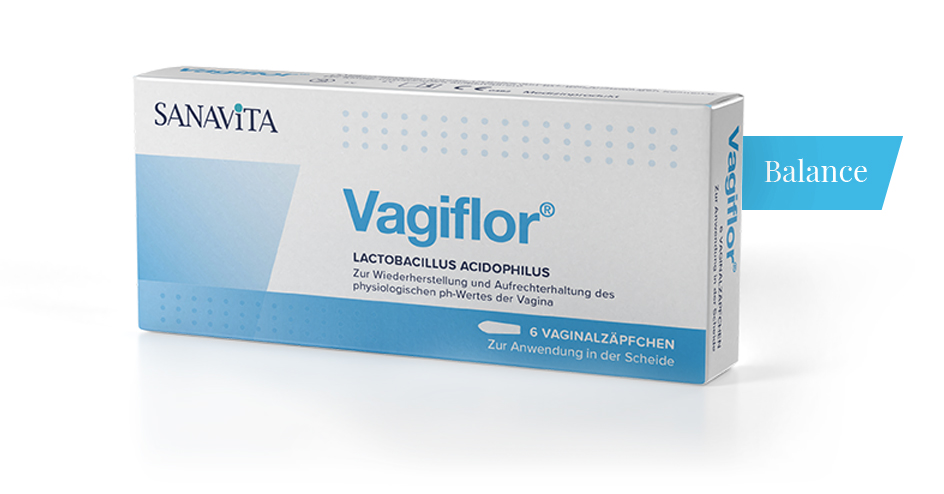Restoring the balance.

Our hotline would be happy to help you with your concerns in a personal and confidential manner and is available to both pharmacies and patients.
06663-9604-16
info@vagiflor.de

Our hotline would be happy to help you with your concerns in a personal and confidential manner and is available to both pharmacies and patients.
06663-9604-16
info@vagiflor.de

Every living being is host to a complex interplay of microorganisms that influence our health — in the genital area as much as anywhere else. When the natural environment in the vagina gets out of balance, bacterial vaginosis can develop. Bacterial vaginosis, formerly also referred to as amine vaginitis, is an illness in which pathogenic bacteria multiply in the vagina whilst the number of protective lactic acid bacteria, also known as lactobacilli, declines.
Bacterial vaginosis – key facts at a glance
In this box, we have summarised all the relevant and useful information from this comprehensive article for you.
Causes: The causes of bacterial vaginosis are not yet fully understood. Various factors are involved in the initial development of the condition.
Risk factors: Essentially, immunological and genetic factors are considered responsible for the development of bacterial vaginosis. Additionally, stress, smoking, hormonal change, bleeding, vitamin D deficiency, the number of sexual partners and certain sexual practices are also thought to foster the occurrence of bacterial vaginosis.
Symptoms: Symptoms include a greyish-white discharge, an unpleasant smell, irritated skin, a burning sensation and itching. Pain may also occur when passing urine and during sexual intercourse. Not every woman will experience these symptoms, however. A raised vaginal pH level is one of the definitive characteristics of bacterial vaginosis.
Treatment: Bacterial vaginosis is treated with a course of antibiotics. The recurrence rate is high because, in the majority of cases, the biofilm (a bacterial membrane that adheres to the vaginal wall) associated with the condition is not eradicated. The supplementary application of lactobacilli has proven effective. This supportive therapy leads to better results. Based on current scientific knowledge, it is not necessary to treat the patient’s partner.
Note: During pregnancy, bacterial vaginosis may lead to complications such as premature delivery. As such, medical treatment is essential. Regular preventive treatment with protective lactobacilli is recommended to ensure healthy and defensive genital flora. Regularly checking the pH level allows for changes in the physiological environment to be quickly recognised and potential problems to be prevented.
The typical symptoms of bacterial vaginosis are a greyish-white discharge, which may grow more intense, and an unpleasant odour. Many affected women, however, do not have either of these symptoms. Bacterial vaginosis is one of the most common conditions affecting the vaginal microbiota (vaginal flora) and affects women of childbearing age. Genetic and external influences may favour the development of bacterial vaginosis.
The clinical pathology was first described by Gardner and Dukes, and in 1984 the condition was defined as a dysbiosis by the World Health Organization (WHO). As a rule, this imbalance in the vaginal environment is treated with antibiotics to prevent the growth and multiplication of the pathogenic bacteria. This frequently also causes collateral damage to the protective lactobacilli, which are indispensable for a healthy vaginal environment. The significance of lactobacilli for women’s health was first recognised by Albert Döderlein (1860-1941). The Döderlein Bacillus, a form of lactic acid bacteria (lactobacilli), was named after him and ensures a healthy vaginal environment.
A multitude of different bacteria make up a healthy vaginal environment, adapting to the physiological changes that occur throughout a woman’s life (variations during the menstrual cycle and menopause being such examples). The presence of specific types of bacteria, such as Gardnerella vaginalis, is not in itself an indicator of illness, and it is well tolerated by an intact immune system. Rather, it is the ratio of individual bacterial strains to one another, along with the strength of the body’s own defences, that determines whether there is illness and whether the vaginal flora can be kept in a healthy state. The ideal pH level is between 3.8 and 4.4. This means that the vaginal environment is acidic, thanks to the lactobacilli. When an imbalance occurs, the pH level rises and it is easier for germs to multiply. An acidic environment prevents the spread of unwanted bacteria, protecting against illness. Further information on the composition of the flora is available here.
The causes of microbiological imbalance and of the elimination of protective lactobacilli are not yet fully understood. Influences on a woman’s vaginal flora include immunological and genetic factors, stress and smoking. Bleeding, oestrogen deficiency and vitamin D deficiency during pregnancy have also been identified as risk factors.
It has also been shown that the risk of bacterial vaginosis increases with the number of sexual partners and when engaging in certain sexual practices. The use of a contraceptive coil is also believed to foster bacterial vaginosis.
Several criteria must be fulfilled before a definite diagnosis of this condition can be made. The prevailing bacterial population varies from one woman to another. The clinical pathology of bacterial vaginosis is dependent primarily on anaerobic bacteria (i.e., bacterial that can survive without oxygen). A decline in protective lactobacilli, which produces H2O2, results in a rise in the pH level, allowing anaerobes to multiply.
The symptoms listed here are typical, but they are not always apparent for every affected person.
Several criteria are essential in determining the presence of bacterial vaginosis. Characteristic symptoms such as the typical odour are not present in every woman, so that other medical attributes must be present for a definitive gynaecological diagnosis.
A native specimen is used for specific tests. The gynaecologist looks at the vaginal secretion under the microscope, checking for medical clue cells. These cells are host to numerous different bacteria and constitute one of the Amsel Criteria upon which a clinical diagnosis of bacterial vaginosis depends. Gardnerella vaginalis is one of the most common bacterial strains in this context.
Other aspects of the Amsel Criteria are the amine (fishy) odour, a greyish-white discharge and a pH level above 4.5. Should 3 of these 4 criteria be present, the gynaecologist can diagnose bacterial vaginosis.
Where bacterial vaginosis has been diagnosed, it must always be treated. Even if the patient is not suffering and the unpleasant symptoms are not present, the condition may result in other infections arising. This includes, for example, inflammation of the uterine lining (endometritis) and of the Fallopian tubes and ovaries (salpingitis and adnexitis).
It is especially important to avoid infection during pregnancy. The risk of premature rupture of membranes (“waters breaking”) and potential premature delivery is increased by bacteria climbing above the cervix, which can thus endanger the pregnancy.
Other possible consequences of untreated bacterial vaginosis include inflammation of the cervix (cervicitis), of Bartholin’s gland (Bartholinitis) and of the outer female genitals (vulvitis). A buildup of pus between the ovaries and Fallopian tubes is also possible, known medically as a tubo-ovarian abscess.
In treating bacterial vaginosis, doctors follow the guidelines issued by the Association of the Scientific Medical Societies in Germany (AWMF).
Bacterial vaginosis is treated with antibotics in accordance with the guidelines, because only very few women recover without treatment. The most common active ingredients are metronidazole and clindamycin. Consulting a gynaecologist makes early treatment possible. This is of great significance for the course of the disease and for recovery expectations.

When treating with a course of antibiotics, it is often not only the germs that are attacked. The lactobacilli that we actually want are also attacked. The result is a deficiency of lactic acid bacteria. Probiotics such as Vagiflor® lactobacilli can reinforce the body’s weakened defences with a targeted rebuilding of flora after a course of antibiotics. Studies also confirm that the use of lactobacilli improves the rate of recovery.
Healthy and stable genital flora is the best prevention.
The longer term use of probiotics over several weeks has shown itself effective. Probiotics influence the immune system and strengthen the body’s defences in a natural way. Clinical tests have shown that the use of lactobacilli improves the rate of recovery from bacterial vaginosis whilst preventing a recurrence of the condition. The condition is often recurrent, as the biofilm it produces (a bacterial membrane that adheres to the vaginal wall) is, in the majority of cases, not eradicated by the antibiotics. This further increases the importance ascribed to healthy and stable flora. Key to this is a consistently low pH level accompanied by sufficient lactobacilli. The long-term use of Vagiflor® lactobacilli is one way to achieve this. The use of condoms during the period of treatment can also help to avoid re-infection.
Women who suffer from bacterial vaginosis can use lactobacilli from Vagiflor® to support the development of a healthy, effectively defensive vaginal environment, preventing a recurrence of the unpleasant symptoms.
Development and transmission of bacterial vaginosis
Although pathogenic bacteria may be transmitted within a partnership, such an imbalance can also arise, even for a healthy woman, without any intimate contact.
In bacterial vaginosis, a so-called biofilm develops, a bacterial membrane that adheres to the vaginal mucosa. Characteristic causes of this biofilm are particular strains of Gardnerella vaginalis and Atopobium vaginae. Current research suggests that this biofilm is also the reason for the high rate of recurrence of bacterial vaginosis, as, in the majority of cases, antibiotic therapy does not completely eradicate the biofilm. The germs can then also be detected in the partner without giving rise to infection. Based on current scientific knowledge, it is therefore not necessary to treat the patient’s partner. Studies have shown that treating the partner has no impact on the frequency of recurrence.
Even though bacterial vaginosis itself is not a sexually transmitted disease, it can increase the risk of other infections.

Special attention is given to a pregnant woman diagnosed with bacterial vaginosis. A gynaecological test and, where appropriate, antibiotic treatment are advisable whenever there is a desire to become pregnant and also in the early stages of pregnancy. This can prevent potential complications in the course of the pregnancy, for example premature delivery.
Natural lactic acid bacteria, such as Vagiflor® lactobacilli, make a proven contribution to intact, effectively defensive genital flora. As well as maintaining healthy vaginal mucosa, they also keep the pH level in a constant acidic range. This systematically counters the incursion and multiplication of pathogenic bacteria (germs).
Thanks to a study conducted by Prof. Erich Saling, founder of an independent preventive programme for pregnant women, a self-test is available that allows women to easily check their pH levels at home and respond to a change quickly.
On the basis of his premature delivery avoidance programme, Prof. Saling has shown that regular pH measurement helps to prevent infections at an early stage and to keep the pH level within a healthy, defensive range, minimising complications in the course of pregnancy.
Sources
Stand: 11/2020
Lactic acid bacteria (lactobacilli) are essential for the health of the female genital area, as they determine the acidity of vaginal flora. The acidic environment of the vagina prevents germs from becoming established there.
Read onThe healthy vagina is certainly not germ-free, but it has a natural protective function. A healthy balance depends on an acidic environment in which harmful yeasts and bacteria cannot survive.
Read on